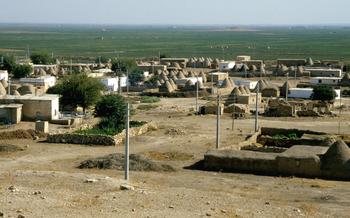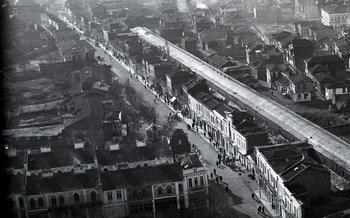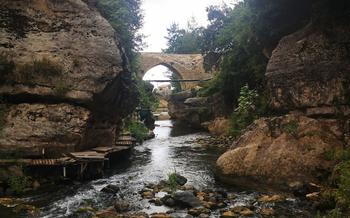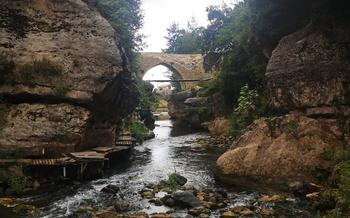
Sariseki Old Houses
- Historical Background
- Location
- Architectural Significance
- Cultural Significance
- Restoration Efforts
- Current State
- Things to See
- Things to Do
- Guided Tours
- Souvenirs and Shopping
- Food and Drink
- Photography Opportunities
- Nearby Attractions
- Accessibility
- Insider Tip
Historical Background
Hatay, a province nestled in the southeastern corner of Turkey, boasts a rich and diverse cultural heritage shaped by its unique geographical location and historical significance. Throughout the centuries, it has been home to numerous civilizations, each leaving its indelible mark on the region's cultural tapestry. Among the most notable remnants of this rich history are the Sariseki Old Houses, a collection of traditional stone houses that stand as a testament to the architectural prowess and cultural traditions of Hatay's past.
The Sariseki Old Houses hold a special place in the history of Hatay. Built during the late 19th and early 20th centuries, these houses were primarily constructed by wealthy merchants and landowners. Constructed using locally sourced materials and traditional techniques, these houses reflect the unique blend of architectural influences that have shaped Hatay's built environment. Their distinct architectural style, characterized by intricate stonework, arched doorways, and traditional courtyards, has earned them recognition as valuable examples of Hatay's cultural heritage.
Location
The Sariseki Old Houses are nestled in the heart of Hatay city, Turkey, within the charming Sariseki district. This historic neighborhood is renowned for its well-preserved old houses, narrow cobblestone streets, and traditional Turkish architecture. To reach the Sariseki Old Houses, visitors can take a leisurely stroll from the city center, immersing themselves in the vibrant atmosphere and local culture. Alternatively, taxis and public transportation are readily available for those who prefer a more convenient option.
From major cities in Turkey, such as Istanbul, Ankara, or Izmir, visitors can take advantage of Hatay's excellent transportation network. Direct flights to Hatay Airport (HTY) are available from various domestic and international destinations. Upon arrival, travelers can rent a car or utilize public transportation to reach the city center. The journey from the airport to the Sariseki Old Houses takes approximately 35-45 minutes by car.
Architectural Significance
The Sariseki Old Houses stand as extraordinary examples of traditional Hatay architecture, showcasing a harmonious blend of local craftsmanship and innovative design. Constructed using a combination of stone, wood, and mud brick, these houses reflect the region's rich cultural heritage. The thick stone walls, often adorned with intricate carvings, provide insulation against the harsh climate, while the wooden beams and lintels support the structure and add a touch of warmth to the interiors. The houses feature distinctive arched doorways and windows, allowing for natural ventilation and creating an inviting atmosphere. The courtyards, a prominent feature, serve as private outdoor spaces, offering a sense of tranquility and privacy. Each house is adorned with unique architectural elements, reflecting the creativity and artistry of its builders, making them a true testament to the architectural prowess of the region.
Cultural Significance
The Sariseki Old Houses are deeply intertwined with the cultural identity of Hatay. They stand as a testament to the city's rich history, diverse influences, and architectural heritage. Each house possesses its unique story, passed down through generations of families who have called these streets home.
The houses have witnessed countless celebrations, ceremonies, and everyday life moments that have shaped the cultural fabric of Hatay. They have served as venues for traditional gatherings, weddings, and religious festivals, fostering a sense of community and belonging among the residents.
The architectural details, such as intricate carvings, colorful tiles, and arched doorways, reflect the artistic and cultural influences that have shaped Hatay over the centuries. These houses embody the city's unique blend of Arab, Turkish, and French elements, creating a distinct architectural style that sets Hatay apart from other regions of Turkey.
Restoration Efforts
Preserving Hatay's cultural heritage is of paramount importance. The Sariseki Old Houses, as valuable historical artifacts, have undergone meticulous restoration efforts. These endeavors aim to maintain the authenticity and integrity of these architectural treasures while ensuring their structural stability.
The challenges faced during restoration were multifaceted. The houses had suffered from years of neglect and natural wear and tear. Sourcing materials and techniques that aligned with the original construction methods was crucial to maintain historical accuracy. Skilled artisans and craftsmen were employed to restore intricate details and decorative elements, ensuring the preservation of the unique character of each house.
Despite the challenges, the restoration efforts have been a resounding success. The houses have been meticulously restored to their former glory, showcasing their architectural splendor and cultural significance. The restoration project has not merely preserved these historical landmarks but has also revitalized the surrounding area, contributing to the cultural and economic development of Hatay.
Current State
Despite the wear and tear of time, the Sariseki Old Houses remain standing as a testament to the enduring spirit of Hatay's history and culture. The restoration efforts have played a significant role in preserving their architectural integrity and safeguarding their stories for future generations.
Although these historic houses have undergone renovations, the interventions have been careful not to alter their original character. The restoration aimed to maintain the authenticity of the structures while ensuring their continued stability and safety for visitors.
Currently, the Sariseki Old Houses are open to the public, inviting visitors to immerse themselves in their rich history and admire their architectural beauty. The houses serve as a vibrant cultural hub, hosting exhibitions, workshops, and events that celebrate Hatay's heritage and traditions.
While the restoration efforts have ensured that these historic houses remain accessible and well-preserved, ongoing maintenance and conservation work is crucial to protect them from the elements and the passage of time. The community and local authorities remain committed to preserving this valuable heritage for the enjoyment and education of future generations.
Things to See
The Sariseki Old Houses are a treasure trove of architectural details and historical artifacts. As you wander through the narrow streets, you'll notice the intricate carvings on the wooden doors, the colorful tiles adorning the facades, and the charming balconies that overlook the cobblestone streets.
Inside the houses, you'll find a wealth of well-preserved artifacts that offer a glimpse into the lives of Hatay's past residents. From antique furniture and traditional clothing to old photographs and handwritten manuscripts, each item tells a story about the city's rich cultural heritage.
Don't miss the opportunity to visit the Hatay Archaeology Museum, housed in one of the restored Sariseki Old Houses. The museum showcases a fascinating collection of artifacts from Hatay's ancient past, including sculptures, pottery, and jewelry. The exhibits provide valuable insights into the region's diverse history and civilizations.
Things to Do
The Sariseki Old Houses offer a range of activities and experiences for visitors to immerse themselves in the rich history and culture of Hatay. Here are some popular things to do:
-
Explore the Historical Streets: Wander through the narrow cobblestone streets of the old city, admiring the preserved architecture and imagining the daily lives of the past residents.
-
Visit the Local Museum: Learn about the history and heritage of Hatay through the exhibits at the local museum, which often showcase artifacts and information about the Sariseki Old Houses.
-
Engage with Local Artisans: Observe and interact with local artisans practicing traditional crafts, such as pottery, weaving, and embroidery, and gain insights into the region's artistic traditions.
-
Attend Cultural Events: Keep an eye out for cultural events and festivals that take place within or near the Sariseki Old Houses, such as music performances, art exhibitions, and traditional dance shows.
-
Take a Cooking Class: Immerse yourself in the culinary delights of Hatay by participating in a cooking class that teaches you how to prepare traditional dishes using local ingredients and techniques.
Guided Tours
Explore with Knowledgeable Guides:
To truly immerse yourself in the history and cultural significance of the Sariseki Old Houses, consider booking a guided tour. Knowledgeable guides, often local experts or historians, can provide insights and anecdotes that bring the houses to life. They can explain the architectural details, share stories of the former residents, and reveal hidden gems that you might otherwise miss. Guided tours are available in various languages, making it accessible to visitors from different backgrounds. Embark on a journey through time as you listen to tales of Hatay's rich past and gain a deeper understanding of the Sariseki Old Houses' role in shaping the city's identity.
Souvenirs and Shopping
As you explore the Sariseki Old Houses, you'll have the opportunity to support local artisans and contribute to the preservation efforts by purchasing unique souvenirs and handicrafts. These items, often handmade with traditional techniques, reflect the rich cultural heritage of Hatay.
From intricately woven rugs and vibrant ceramics to hand-embroidered textiles and delicate jewelry, there's a treasure trove of authentic souvenirs to choose from. Each piece tells a story of the region's craftsmanship and artistry, making it a meaningful memento of your visit.
By purchasing these locally made items, you not only take home a piece of Hatay's culture but also contribute to the livelihoods of the skilled artisans who create them. Their dedication to preserving traditional crafts ensures that the essence of Hatay's heritage continues to thrive.
So, as you wander through the narrow streets and courtyards of the Sariseki Old Houses, be sure to set aside some time to explore the local shops and bazaars. Engage with the friendly artisans, learn about their techniques, and select a unique souvenir that will remind you of your time in this enchanting city.
Food and Drink
As you wander through the enchanting alleys of the Sariseki Old Houses, don't miss the opportunity to savor the delectable local cuisine. The area is home to several charming restaurants and cafes that offer a delightful culinary journey.
Indulge in the aromatic flavors of traditional Turkish dishes, such as Iskender Kebab, a mouthwatering combination of thinly sliced meat, yogurt, and tomato sauce served over crispy bread. Kunefe, a sweet and savory pastry filled with cheese and topped with syrup and pistachios, is a must-try dessert that will tantalize your taste buds.
For a truly authentic experience, visit the local markets to sample fresh produce and handmade delicacies. Pick up some Antakya peynir, a local cheese known for its distinct flavor, or savor the sweetness of pestil, a dried fruit roll made with grapes or apricots.
As you sip on a refreshing glass of tahinli ayran, a blend of yogurt, tahini, and water, take a moment to soak in the vibrant atmosphere of the old town. The friendly locals are always ready to share stories about their culinary traditions, making your dining experience not just a feast for the palate but also a cultural immersion.
Photography Opportunities
The Sariseki Old Houses present a treasure trove of photography opportunities for enthusiasts of all levels. With their captivating architecture, charming streets, and picturesque corners, these historical residences offer a feast for the eyes.
Architectural Details: - Focus on the intricate carvings, ornate facades, and unique architectural elements that make each house stand out. - Experiment with different angles and lighting to capture the interplay of shadows and textures.
Street Scenes: - Capture the vibrant street life, with locals going about their daily routines, creating a sense of authenticity. - Look for interesting interactions, colorful clothing, or traditional activities that add a human element to your shots.
Doorways and Windows: - Pay attention to the intricate designs and craftsmanship of the doorways and windows, which often tell stories of their own. - Frame your shots to create a sense of depth and mystery, leading the viewer's eye into the hidden corners of the houses.
Panoramic Views: - Climb to the rooftops or higher vantage points to capture stunning panoramic views of the old town and the surrounding landscape. - Experiment with wide-angle lenses to encompass the vastness of the scene and create a sense of grandeur.
Sunrise and Sunset: - Plan your visit during the golden hours of sunrise and sunset to capture the warm hues that bathe the Sariseki Old Houses in a magical glow. - Experiment with silhouettes and long shadows to create dramatic and evocative images.
Nearby Attractions
Hatay is a treasure trove of historical sites and landmarks, and the Sariseki Old Houses are just a starting point for exploring the region's rich cultural heritage. In the immediate vicinity, visitors can discover the stunning Citadel of Hatay, an ancient fortress that has stood for centuries, offering panoramic views of the city and beyond. The Great Mosque of Antakya, with its intricate Islamic architecture and serene atmosphere, is another must-see attraction.
For those interested in deeper historical immersion, the Hatay Archaeology Museum houses an impressive collection of artifacts from various civilizations that have called the region home. From ancient mosaics to pottery and jewelry, the museum provides a glimpse into Hatay's diverse past.
To plan a comprehensive itinerary, consider exploring other notable landmarks in the area. The Church of St. Peter, with its unique blend of architectural styles, is a testament to Hatay's religious diversity. The Habibi Neccar Mosque, said to be the final resting place of Jesus's uncle, is another sacred site worth visiting.
By combining a visit to the Sariseki Old Houses with these nearby attractions, travelers can create a rich and fulfilling experience that delves into the heart of Hatay's historical and cultural tapestry.
Accessibility
The Sariseki Old Houses strive to provide an inclusive and enjoyable experience for all visitors. Accessible pathways and ramps have been implemented throughout the site to ensure that individuals with disabilities can navigate the area with ease. Additionally, designated parking spaces are available close to the entrance for added convenience. Visitors with special needs are encouraged to inform the staff upon arrival, and they will be happy to assist in any way possible. By prioritizing accessibility, the Sariseki Old Houses aim to create a welcoming and accessible environment for everyone who wishes to explore this historical gem.
Insider Tip
Venture beyond the main tourist areas to discover hidden gems within the Sariseki Old Houses. Explore the narrow alleyways, where you'll find charming courtyards and tucked-away cafes. Seek out the less-visited houses, where you can immerse yourself in the authentic atmosphere and engage with local residents. These hidden corners offer a glimpse into the daily life and traditions of Hatay, providing a deeper understanding of the city's cultural heritage.
To avoid the crowds and make the most of your visit, plan your trip during the shoulder seasons (spring and autumn) when the weather is still pleasant but there are fewer tourists. This will allow you to explore the houses at a more leisurely pace and enjoy a more intimate experience.









